-

人教版高中英语必修4Theme parks说课稿3篇
The oldest and the most popular park in the worldenjoy the exciting activities thereget close to the life-size cartoon characters like Mickey Mouse and Donald Duck Step 3 Pre-reading1.What do you suppose a theme park is ?2.What do you think you can see in a theme park?(1.It is a kind of amusement park which has a certain theme – that the whole park is based on. 2.buildings, castles, statues, rare animals and birds, and so on.) Step 4 Reading ----- Theme Parks –---- Fun and More Than Fun1.Predict : Read the title and the pictures on P. 34 and PredictWhat is the meaning of the title “Theme Park – Fun and more than fun”?(The title means that theme parks are fun to visit, but that they can also be educational and can offer useful information.)2.Skimming Fast read and answer:What activities can we take in a theme park?Amusement park: Bumper car Merry-go-round slide bungee jumping Free-fall rides Horror films Pirate ship Ferris wheel roller coaster3.Scanning Read again and you will find various theme parks are mentioned in the passage . Then what are they ?Theme parks: Sports theme park History theme park Culture theme park Marine or Ocean theme Park Future park Science theme park Disneyland4.Careful reading and find the main idea of each paragraph:THEME PARKS---- entertaining/ educationalPara.1 Traditional parks are places to go for relaxation and to have time away from our busy lives.Para.2 Theme parks are different They’re large and full of things to do, see and buy.Para.3 Theme parks are built around a single idea or theme. One example is a sports park.Para.4 Another kind of theme park is historical more and cultural and can be educational.Para.5 Disneylandwas the first theme park. It is based on the fantasy life and characters of Disney’s films.Para.6 Some examples of educational theme parks include sea world parks and science parks.

人教版高中英语必修3Healthy Eating说课稿4篇
Language learning needs a context, which can help the learners to understand the language and then can product comprehensible output, so computer has the advantages to make the materials attractive.Part 3 Learning MethodsTask-based, self-dependent and cooperative learningPart 4 Teaching ProcedureStep One Lead-in“Interest is the best teacher.” Therefore, at the very beginning of the class, I should spark the students’ mind to focus on the centre topic “the band”. I’ll show some pictures of food to attract their attention and then bring some questions.Question:What kind of food they like?What should go into a good meal?The answers must relate to the diet. After this, the students will be eager to know something about a balance diet and this is the very time to naturally lead the class into Step 2Step 2 Reading for information: skimming and scanning In this step, I use Task-based Language Teaching method, which can give students a clear and specific purpose while skimming and scanning the context.Task 1 General ideaThe students will be asked to just glance at the title and the pictures of the passage, and then guess what they will read in the text. And they’ll be divided into groups of four to have a discussion.The purpose is to inspire the students to read actively, not passively. In addition, the task is to develop the students’ reading skill by making prediction and to encourage the students to express their thoughts in English and cooperate with each other.Task 2 Main idea of each paragraphCooperative learning can raise the students’ interest and create an atmosphere of achievement. Based on this theory, I divide the whole class into 4 groups to skim the whole text and get the main idea of each paragraph.

人教版高中英语必修3The million pound bank note说课稿3篇
在接下来的细读环节,我套用了高考对阅读理解的考查方式设置了5个问题,分别为三个推理判断题,一个细节题和一个主旨大意题。学生需要对文章的内容进行分析、归纳、推理、猜测等高级思维活动才能做出正确的回答。【设计意图】这一过程是对学生进行细读的训练,培养学生获取特定信息和挖掘文章深层次信息的能力。第三环节:Intensive-reading (精读) 15′第三个环节精读,既是最重要的环节,也是突破本课重难点的关键。首先,让学生思考剧本中人物看到百万英镑前后的态度发生了怎样的变化。其次,让学生仔细阅读文章,找出可以表现人物态度变化的具体的语言和动作。最后,让学生总结人物的态度发生变化的根本原因是什么,从而引出Money Talks, 供学生思考。【设计意图】通过一系列的活动培养学生学习从人物的语言和动作探究人物的心理,使学生进一步体会戏剧语言的魅力,从而对文章背后所反映的社会问题进行思考,也为下一步的讨论环节做好铺垫。

人教版高中英语必修5First aid说课稿6篇
In this class, I have 3 teaching aims, that is, knowledge aims, ability aims and emotion aims.1) Knowledge-Teach students new words and expressions, such as temporary, bleed,sprain choke, first aid, fall ill and so on.-Enable students to have a better understanding for some basic knowledge of first aid.2) Ability-Train students’ speaking, reading and writing abilities by different teaching activities, such as skimming, comprehending, team work, role play, retelling and writing.-Develop students’ reading strategy on how to move general idea to specific information.3) Emotion-Promote students’ awareness of giving first aid.- Cultivate students’ creativities.Then let’s come to my teaching methods and activities.III. Teaching methods and activities:To achieve different teaching aims, various kinds of teaching methods and activities will be adopted throughout this period, such as TBL (task-based learning), skimming, team work, brainstorm and others, which can offer students opportunities to fulfill tasks in which they can use language to achieve a specific outcome.IV. Teaching aids:Computer and blackboardV. Teaching important points:1) Make students have a clear mind for the structure of the text.2) Help students understand the theme of the text.VI. Teaching difficulties:1) So many new words may affect students’ understanding.2) How to get students to know about the functions of the skin and thecauses, characteristics and treatments for different degree burns,and the knowledge about giving first aid. VII. Blackboard design:

人教版高中英语必修5Great scientists说课稿4篇
通过写文章梗概,培养学生综合运用语言的能力,学习用恰当的英语描述科学家的故事。这是本课的教学难点。教师可以使用完形填空的方式来帮助学生整理语篇,从而来降低难度。本课的教学重点的突破方法是:在阅读前,让学生初步了解得出科学观点所需要的基本程序,从而轻松而自然地导入文章的阅读;在阅读过程中,由易到难设计快速阅读和精读的问题,层层推进各种阅读活动,让学生对阅读内容从整体感知到细节理解,最后深层读懂整篇文章,同时加强阅读策略的指导,让每个学生都主动参与课堂教学活动,最终达到提高阅读能力的目的。Step 4 Post-readingGroup Activities四人小组共同合作,在老师的适当指导下,就以下2个问题展开讨论,让学生就所知、所学、所感和所想融入话题,然后抽若干同学代表作小组发言。1. What do you think about John Snow, and what should we learn from him?2. Cholera was 19th century disease, which two diseases are similar to cholera today? Why?

人教版高中英语必修5Life in the Future说课稿5篇
Good afternoon, everyone. It’s my great pleasure to be here sharing my lesson with you. The content of my lesson is Senior English for China Book5 Unit 3 Life in the Future. I’ll be ready to begin this lesson from six parts: Analysis of the teaching material, Analysis of the students, Teaching aims and important and difficult points, Teaching methods and aids, Teaching procedures, and Blackboard design. First, let me talk about the teaching material.Part 1 Analysis of the Teaching Material:This unit is about what human beings’ life will be like in about one thousand years. By studying of this unit, we’ll Enable the students to know the changes in humans’ life and some new inventions bringing about the change and develop the interest in science. This lesson plays an important part in the English teaching in this unit. This is an important lesson in Book Five. From this lesson, it starts asking the Ss to grasp contents of each passage. Therefore, this lesson is in the important position of the teaching material. If the Ss can learn it well, it will be helpful to make the Ss learn the rest of this unit.Part 2 Analysis of the SsAs Senior2 Ss, they are at different levels of English fluency, some of them have lost interest in English. So during the lesson, I arrange a variety of activities to let all of them join in to attract their interest and let them be confident and taste the joy of success.

人教版高中英语必修5Making the news说课稿4篇
今天我们来介绍一下必修五第四单元的授课方式。这个单元的题目是Making the news。应该是学生比较感兴趣的话题,学生往往对新闻工作充满好奇,所以我们可以利用这个机会多设计一些师生互动和学生互动,来激发起学习的积极性,提高学习效率。同时我们可以利用这个单元不仅帮助学生掌握语言知识,培养语言能力,同时让其了解新闻工作的重要性,培养起社会智能感。这个单元分为六个课时,它的教学目标是这样的:语言目标是掌握词汇表中的常用单词和短语,掌握倒装句的一些基本用法。 技能目标是能初步掌握约会的基本句型并在真实的场景下正确运用。新闻报道类文章的写作技能。采访的基本规范和沟通技能。情感目标是对新闻报道的客观性和真实性有更好的理解。对新闻记者的职业有更深入的了解,并能体会其工作的重要性。下面我们来介绍一下第一课时的授课方式,第一课的教学目标是这样的第一课时的教学目标语言目标:单词:Occupation, journalist, editor, photographer, curious, personality, enthusiasm

人教版高中英语必修5The United Kingdom说课稿4篇
Teaching Aims:Knowledge 1. Get the students to learn the useful new words and expressions in this section. Aims:2. Let the students learn about how the UK was formed and the four groups of invaders.1. Develop students’ reading ability and let them learn different Ability reading skills. Aims:2. Enable students to learn to talk about the United Kingdom and the Union Jack Emotional 1. Let students know more about the UK2. Develop students’ sense of cooperative learning Aims:Teaching Important Points:1. Let the students learn about the countries of the United Kingdom and the Union Jack2. Get the students to read the passage and know about how the UK was formed and the four groups of invaders.3. Have the students learn different reading skills.Teaching Difficult Ponts:1. Develop students’ reading ability.2. Enable students to talk about the United Kingdom and the Union Jack.3. Let students learn how the UK was formed geographically and historically.Teaching Methods:Showing pictures, asking, exercising, listening, reading etc.Teaching Aids:A computer,a projector and a blackboard.Teaching Procedures: 1) Show a map of the world, ask students the following questions:Where is the UK?What’s the full name of the UK?2) Ask the students work in pairs to do the quiz on Page 9.Do you want to test how many things you know about the United Kingdom? Let’s have a small test.Using the map on P9, students answer the following questions:?How many countries does the UK consist of? What are they??England is divided into three main areas. Do you know what they are? 1) Scanning (10Minutes )Let the students hold the questions asked in pre-reading and read the passagequickly and then let them do the following exercise.Join lines to the right answer.

人教版高中英语必修3Canada-the true north说课稿4篇
Good afternoon, teachers, It’s my great pleasure to be here sharing my lesson with you.The content of my lesson is Senior English Book 3 Unit 5 Canada —— “The true North”.I’ll be ready to begin this lesson from five parts. Analysis of the teaching material,the teaching methods,the studying methods, the teaching procedure,and Blackboard design.First, let me talk about the teaching material.Part 1 Teaching Material:This unit is about the introduction of Canada. By studying of this unit,we’ll enable the students to learn the geography, population, main cities, and natural beauty, natural resources of Canada. Through the training of the unit, it also requires students to learn some Language skills such as the expressions of position and emotions.So it plays an important part in the English teaching in this book.After studying the teaching material and analyzing the rule of children’s growing of mind,I think the teaching aims are the followings:1.Knowledge objects:(1) make the students learn some new words and phrases(2) make the students understand the content of the lesson.2.Ability objects:(1)To develop the Ss’ abilities of listening, speaking, reading and writing. Especially reading and speaking ability.(2) learn to talk about the characters of Canada in English(3)To train the Ss’ ability of working in pairs.3.Emotion objects:(1)Enable students to understand the characters of Canada..(2)Stimulate Ss to work hard to make China stronger.Part 2 Teaching Methods:I think helping students learn to master new words and phrases and improve the students’ reading and speaking ability is import and the difficult.According to the analysis of the teaching material and the import points and the difficult points,I will use the following teaching methods : question-guiding approach; fast-reading and careful reading; multi-media teaching methods; discussion
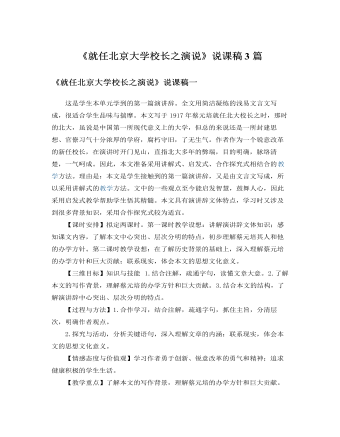
人教版高中语文必修2《就任北京大学校长之演说》说课稿3篇
(三)教学重、难点1、教学重点:结合课文,了解演讲辞针对性强、条理清楚、通俗易懂、适当的感情色彩等特点。2、教学难点:深入理解文章内涵,联系现实,体会本文的现实意义二、说学情高中学生在初中阶段已经接触过演讲辞了,对演讲词的特点已经有了一些基本的知识,因此本轮的教学应该让他们在此基础上有所提高。本文是学生在高中阶段第一次接触演讲辞,有必要让他们了解演讲辞的特点及课文如何体现这些特点的。随着年龄的增长,生活阅历的增加,高中学生正逐渐形成自己对世界、对人生的看法,蔡元培先生的这篇文章能很好地激发他们对当前的高中学习和未来的大学生活进行思考。此外,学生对北大的历史及蔡元培先生作这番演讲的时代背景了解不深,应作出补充说明。
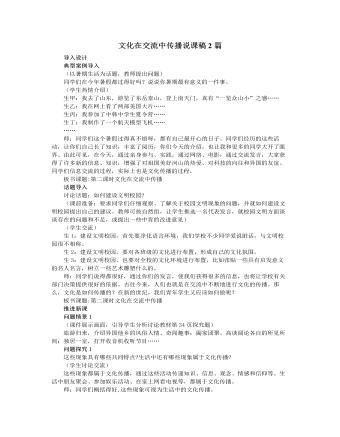
人教版高中政治必修3文化在交流中传播说课稿2篇
师:同学们这个暑假过得真不错呀,都有自己最开心的日子。同学们经历的这些活动,让你们自己长了知识,丰富了阅历,你们今天的介绍,也让我和更多的同学大开了眼界。由此可见,在今天,通过亲身参与、实践,通过网络、电影,通过交流发言,大家获得了许多新的信息、知识,增强了对祖国美好河山的热爱、对科技的向往和异国的友谊。同学们信息交流的过程,实际上也是文化传播的过程。板书课题:第二课时文化在交流中传播话题导入讨论话题:如何建设文明校园?(课前准备:要求同学们仔细观察、了解关于校园文明现象的问题,并就如何建设文明校园提出自己的建议。教师可按自然组,让学生推选一名代表发言,就校园文明方面谈谈存在的问题和不足,或提出一些中肯的改进意见)(学生交流)生1:建设文明校园,首先要净化语言环境,我们学校不少同学爱说脏话,与文明校园很不相称。
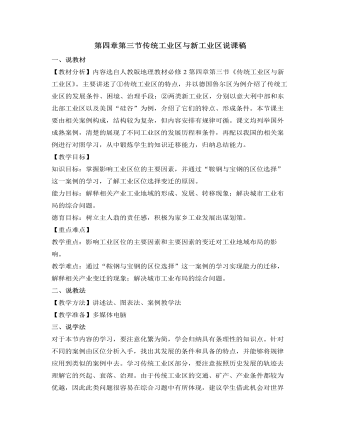
人教版高中地理必修2第四章第三节传统工业区与新工业区说课稿
下面是对以高技术产业为主的新工业区的内容进行讲解,教材以美国“硅谷”为例,首先谈的是高技术工业的特点,然后讲述的是“硅谷”的发展条件,由于教学模式与意大利新工业区的内容基本一致,这里就不再赘述了。接下来教材中提到的与之对照的案例同样是以高技术产业而闻名的中关村,由于中关村在国内的知名度较高,一般学生都有所了解,因此不妨让学生谈谈自己的看法:对于高新技术产业的发展有何建议,相对于发展较为成功的“硅谷”我们需要学习的方面又是哪些?案例中最后一个问题很值得深省,我国的新工业区到底怎样做才能够获得成功,简单的模仿下我们缺少的又是什么?这个问题可以作为拓展,让学生写一篇简短的论文作为课后作业。最后做以简单的课堂小结。本节内容的教学可能会相对繁杂,而案例之间的分析过程又过于雷同,所以难免枯燥。在处理这个问题上,我将尽量做到详略得当,主要培养学生的自主学习能力。
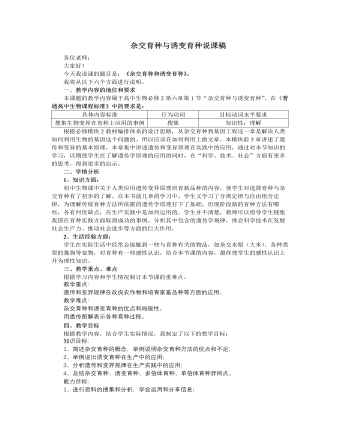
人教版高中生物必修2杂交育种与诱变育种说课稿
二、诱变育种1、创设情境,引出课题 出示教具或图片:一穗具有黄粒性状的玉米。问题:怎样利用现有的玉米品种培育出具有黑色性状的玉米新品种呢?2、阅读资料、讨论研究 课前布置兴趣小组同学搜集有关航天诱变育种的资料,并在此基础上进行整理。这样可以培养学生搜集并且整理资料的能力,并体会科学技术与人们生产生活的密切联系。 学生阅读生物兴趣小组课前搜集的有关航天诱变育种问题的资料及教材P100得内容。以小组为单位讨论回答有关诱变育种的有关问题,附:设置的问题:1、 新品种中有没有产生新基因?2、空中诱发基因突变的条件有哪些?3、航天诱变育种有哪些优点?4、地面上有哪些因素可以诱发生物体产生基因突变?5、诱变育种有哪些局限性?如何克服?以航天诱变育种为典型,解决诱变育种过程中遇到的相关问题。让学生学会对已有知识进行应用。3、归纳总结,形成体系 通过以小组为单位的表达和交流,师生共同总结归纳,形成有关诱变育种的知识体系,提升学生对于知识的理解。
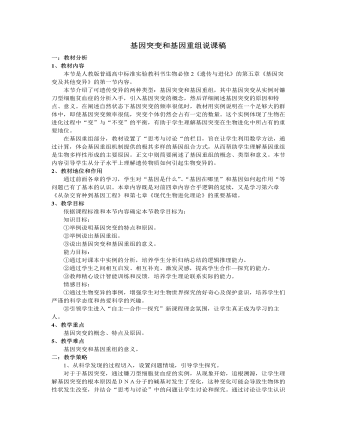
人教版高中生物必修2基因突变和基因重组说课稿
1、教材内容本节是人教版普通高中标准实验教科书生物必修2《遗传与进化》的第五章《基因突变及其他变异》的第一节内容。本节介绍了可遗传变异的两种类型:基因突变和基因重组,其中基因突变从实例对镰刀型细胞贫血症的分析入手,引入基因突变的概念,然后详细阐述基因突变的原因和特点、意义。在阐述自然状态下基因突变的频率很低时,教材用实例说明在一个足够大的群体中,即使基因突变频率很低,突变个体仍然会占有一定的数量。这个实例体现了生物在进化过程中“变”与“不变”的平衡,有助于学生理解基因突变在生物进化中所占有的重要地位。在基因重组部分,教材设置了“思考与讨论“的栏目,旨在让学生利用数学方法,通过计算,体会基因重组机制提供的极其多样的基因组合方式,从而帮助学生理解基因重组是生物多样性形成的主要原因。正文中则简要阐述了基因重组的概念、类型和意义。本节内容引导学生从分子水平上理解遗传物质如何引起生物变异的。
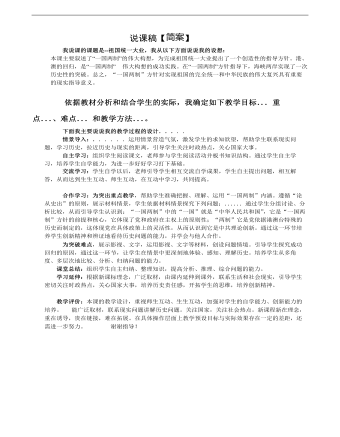
高中历史人教版必修一《第22课祖国统一大业(简案)》说课稿
情景导入:......运用情景营造气氛,激发学生的求知欲望,帮助学生联系现实问题,学习历史,拉近历史与现实的距离,引导学生关注时政热点,关心国家大事。自主学习:组织学生阅读课文,老师参与学生阅读活动并板书知识结构。通过学生自主学习,培养学生自学能力,为进一步好好学习打下基础。交流学习:学生自学以后,老师引导学生相互交流自学成果,学生自主提出问题,相互解答,从而达到生生互动、师生互动,在互动中学习,共同提高
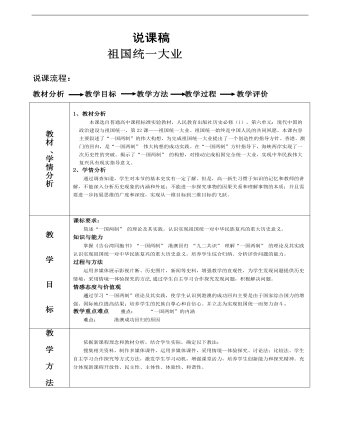
高中历史人教版必修一《第22课祖国统一大业》说课稿
1、教材分析 本课选自普通高中课程标准实验教材,人民教育出版社历史必修(1),第六单元:现代中国的政治建设与祖国统一,第22课——祖国统一大业。祖国统一始终是中国人民的共同夙愿。本课内容主要叙述了“一国两制”的伟大构想,为完成祖国统一大业提出了一个创造性的指导方针。香港、澳门的回归,是“一国两制” 伟大构想的成功实践。在“一国两制”方针指导下,海峡两岸实现了一次历史性的突破。揭示了“一国两制” 的构想,对推动完成祖国完全统一大业,实现中华民族伟大复兴具有现实指导意义。 2、学情分析通过调查知道,学生对本节的基本史实有一定了解。但是,高一新生习惯于知识的记忆和教师的讲解,不能深入分析历史现象的内涵和外延;不能进一步探究事物的因果关系和理解事物的本质;并且需要进一步拓展思维的广度和深度,实现从一维目标到三维目标的飞跃。

人教版高中语文必修5《说“木叶”》教案
【教学目标】Ⅰ、学习理解诗歌语言的暗示性特质。Ⅱ、根据诗歌语言的特质,进行迁移,领略诗歌的精妙之处,给同学如何鉴赏诗歌提供实感。㈠、导入:各位同学,有个成语叫"一字千金"。对我而言,第一次领略到一个字的分量,是在小学三年级的时候,一次作文评析课上。当时我对自己的文章充满了期待,希望能得到老师的赞赏。记得老师进来后的第一句话是"有一篇文章,我就冲它用了一个字,我给它打95分。打这样的高分,对我来说,是极为难得的。"同学都充满了好奇,老师接着说"这个字就是一个'悟'字。我们的同学都说我学到了,我明白了,我懂得了一个道理,而这位同学却用了一个'悟'字,难能可贵。"这篇文章不是我的,在羡慕的同时,一个字在文章中的分量就深深的刻在了我的心上。文学作品中,一个字精妙与否,足以决定作品是流光溢彩,还是黯然失色。尤其是我们的古典诗词,用简短的几个字,造就的却是丰富的情感与博大的意境。读后满口余香,却是妙处难与君说。这跟诗歌的语言是密不可分的。今天,我们就通过《说"木叶"》一文,对中国古典诗词语言特质作一番探幽。
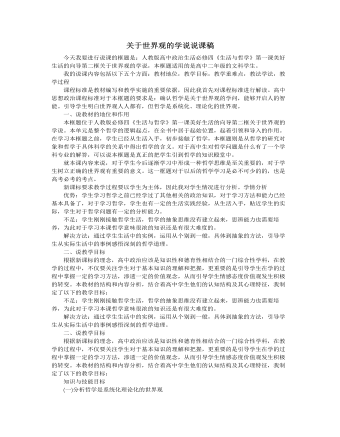
人教版高中政治必修4关于世界观的学说说课稿(一)
3、课堂小结,强化认识。(2—3分钟)通过总结本课的知识,简单的用三个概念三个关系,简明扼要的总结出本节课的知识,突出本框题的重难点。其中重点给学生梳理一下哲学的含义,使学生在学习的最后对于哲学有一个全面而准确的理解,强化学生对于哲学的认识。4、课堂练习针对高中学生初步接触哲学,运用哲学思维来分析哲学问题的能力还需要今后的培养,我进行了分层的方式来设计习题,这样设计一方面符合学生认知的能力,由简单到困难,一步步的深入,另一方面,在练习的过程中,也可以使学生巩固基础知识,使学有余力的学生继续提高,充分考虑到学生的实际情况。5、板书设计为了强化教学效果,我会在授课的过程中适时的书写板书,我的板书设计总的来说是以简洁明了的形式展示,便于学生一目了然的把握本节课的重难点,也可以建立知识间的联系,便于学生形成完整的知识体系。
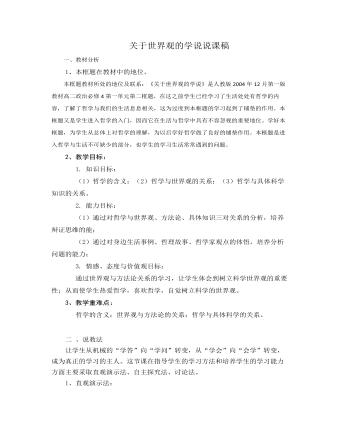
人教版高中政治必修4关于世界观的学说说课稿(二)
一、教材分析1、本框题在教材中的地位。本框题教材所处的地位及联系:《关于世界观的学说》是人教版2004年12月第一版教材高二政治必修4第一单元第二框题,在这之前学生已经学习了生活处处有哲学的内容,了解了哲学与我们的生活息息相关,这为过度到本框题的学习起到了铺垫的作用。本框题又是学生进入哲学的入门,因而它在生活与哲学中具有不容忽视的重要地位。学好本框题,为学生从总体上对哲学的理解,为以后学好哲学做了良好的铺垫作用。本框题是进入哲学与生活不可缺少的部分,也学生的学习生活常常遇到的问题。2、教学目标:1. 知识目标:(1)哲学的含义;(2)哲学与世界观的关系;(3)哲学与具体科学知识的关系。2. 能力目标:(1)通过对哲学与世界观、方法论、具体知识三对关系的分析,培养辩证思维的能;(2)通过对身边生活事例、哲理故事、哲学家观点的体悟,培养分析问题的能力;

人教版高中语文必修3《爱的奉献 学习议论中的记叙》说课稿
教学过程:(一)导入:课前放《爱的奉献》歌曲,同时不断播放一些有关“爱”的主题的图片,渲染一种情感氛围。师说:同学们,谁能说说这组图片的主题应该是什么?生(七嘴八舌):母爱,不对是亲情……是友情、还有人与人互相帮助……那组军人图片是说保卫国家,应该是爱国……那徐本禹和感动中国呢?…………生答:是关于爱的方面师说:不错,是关于爱的方面。那么同学们,今天就以“爱的奉献”为话题,来写一篇议论文如何?生答:老师,还是写记叙文吧。生答:就是,要不议论文写出来也象记叙文。师问:为什么?生答:老师,这个话题太有话说了,一举例子就收不住了,怎么看怎么象记叙文。生答:就是,再用一点形容词,就更象了。众人乐。师说:那么同学们谁能告诉我,为什么会出现这种问题?一生小声说:还不是我们笨,不会写。师说:不是笨,也不是不会写,你们想为什么记叙文就会写,一到议论文就不会了,那是因为同学们没有明白议论文中的记叙与记叙文中的记叙有什么不同,所以一写起议论文中的记叙,还是按照记叙文的写法写作,这自然就不行了。那好,今天我们就从如何写议论文中的记叙讲起。